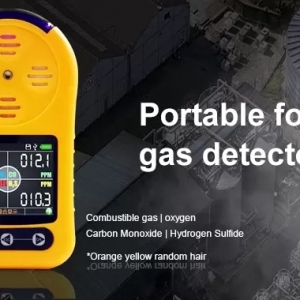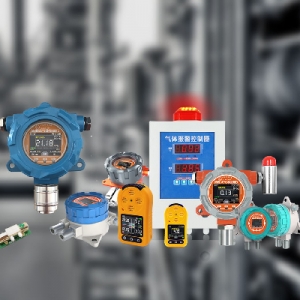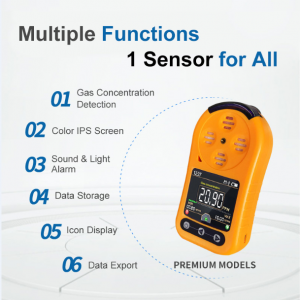Understanding Water quality Sensors
The water quality sensors measure pH, ORP, conductivity, dissolved oxygen, residual chlorine, turbidity, salinity, BOD, COD and other water quality parameters through various methods such as chemical, physical and biological reactions of water, providing data support for researchers, observers and engineers. Applications include laboratory research, environmental management improvement, marine water quality evaluation, hydraulic model calibration, wastewater treatment, etc.

What is a water quality sensor?
Water quality sensor is a general term for a variety of sensors that measure PH, ORP, residual chlorine, turbidity, suspended solids, COD, BOD, conductivity, salinity, and dissolved oxygen. Water quality does not refer to a specific daily parameter, it contains a number of elements to measure the status of water quality.
Types of water quality sensors
Water quality is a general concept that covers a wide range. Therefore, building a complete water quality monitoring system is a complex project. The good news is that with these nine Apure water quality sensors and a water quality monitoring system, you can easily build your entire water quality monitoring system.
1. water pH Sensor
Water PH is an important indicator for monitoring industrial wastewater. In industrial wastewater, the adaptation range of most microorganisms is pH 4.5-9, and the optimum pH range is 6.5-7.5. When the pH value is below 6.5, fungi start to compete with bacteria. When pH reaches 4.5, the bacteria will dominate in the biochemical tank and seriously affect the sludge settling. When the pH value exceeds 9, the metabolic rate of microorganisms will be hindered.

In order to monitor the PH value of industrial wastewater, we generally use water PH sensors. PH sensors are sensors that are used to monitor the concentration of hydrogen ions in the measured solution and convert it into a corresponding usable output signal. It is suitable for industrial wastewater, domestic wastewater, agriculture, aquaculture and other non-corrosive weak acidic and weak alkaline environment scenarios.
2.Water EC Sensor
Water EC is the ability to conduct electric current in a body of water. In water quality monitoring, conductivity is one of the important indicators to reflect water quality. The higher the conductivity value of water, the better the conductivity, the greater the TDS value in water. the TDS value represents the content of dissolved impurities in water. the greater the TDS value, the greater the content of impurities in water. Conversely, the smaller the impurity content, the greater the water. Pure, the lower the conductivity.

Water EC sensor according to the principle of work is divided into the electrode conductivity sensor, inductive conductivity sensor. Electrode conductivity sensors use resistance measurement method based on electrolytic conduction principle. Inductive conductivity sensors are based on the principle of electromagnetic induction to achieve the measurement of liquid conductivity.
JXCT sensor adopts electrode type conductivity measurement method with built-in high precision sensor, high accuracy, conductivity measurement range between 0~20,000μS/cm, measurement error is ±1%FS, high sensitivity. This conductivity sensor comes with a cable connected to a transmitter that sends the signal to processing and/or recording equipment.

3. Water Dissolved Oxygen (DO) Sensor
The molecular oxygen in the air dissolved in water is called dissolved oxygen. The content of dissolved oxygen in water is closely related to the partial pressure of oxygen in the air and the temperature of water. Under natural circumstances, the oxygen content in the air does not change much, so the water temperature is the main factor, the lower the water temperature, the higher the dissolved oxygen content in the water. The molecular oxygen dissolved in water is called dissolved oxygen, usually denoted as DO, and is expressed in milligrams of oxygen per liter of water. The amount of dissolved oxygen in water is an index to measure the self-purification capacity of water body.
4.Water Residual Chlorine Sensor
Water Residual chlorine is the general term for the free and bound chlorine remaining in the water after chlorination disinfection and exposure for a certain period of time.

The residual chlorine sensor is used to measure residual chlorine, chlorine dioxide and ozone in water. The electrode structure is simple and easy to clean and replace. It can be used in drinking water treatment plants, canneries, drinking water distribution networks, swimming pools, cooling circulating water, water quality treatment projects, etc. where the residual chlorine content in aqueous solutions needs to be continuously monitored.
5. Water Turbidity Sensor
Turbidity is caused by suspended particles in the water. The suspended particles diffusely reflect the incident light. Scattered light in the 90 degree direction is usually used as the test signal. The scattered light and turbidity are linear in multiple segments, so the sensor needs to be calibrated at multiple points.

The turbidity sensor is designed and manufactured using the principle of scattered light turbidity measurement. It accurately measures the amount of light passing through the water body to accurately measure the suspended matter in the water, which can reflect the pollution of the water body. In this way the turbidity in the water sample is measured and the final value is output after linearization. Commonly used in water quality detector for accurate measurement of rivers, sewage, wastewater.
7. Water Chemical Oxygen Demand (COD) Sensor
Many organic substances dissolved in water absorb UV light. Therefore, by measuring the degree of absorption of organic matter to 254 nm ultraviolet light. The Water COD Sensor accurately measures the amount of organic pollutants in the water.

The water COD sensor uses two light sources. One is ultraviolet light that measures COD content in water, and the other is reference light that measures turbidity in water. Optical path attenuation is feasible to a certain extent through a specific algorithm. Eliminate the interference of particulate suspended impurities, thus achieving more stable and reliable measurement.
8.Ammonia Nitrogen Ion (NH3-N)Sensor
In aquaculture, if the ammonia nitrogen level in the water is too high, it will poison the fish and shrimp and cause them to die. Therefore, water quality ammonia hydrogen sensors are especially necessary for monitoring ammonia nitrogen concentration. Ammonia nitrogen sensors are used to measure ammonia nitrogen content in water quality. People use it in areas such as the Internet of Things, aquaculture, and smart agriculture.

JXCT型氨氮传感器采用基于PVC薄膜的铵离子选择性电极。它是一种监测水中铵离子的传感器。具有温度补偿功能,检测快速、简单、准确、经济。
结论
水质传感器涉及的领域很广,不同的应用场所需要监测不同的参数,设计方案也大不相同。具体产品选型和技术操作请联系我们。我们拥有专业的技术工程师,为您提供最佳的配套方案。






